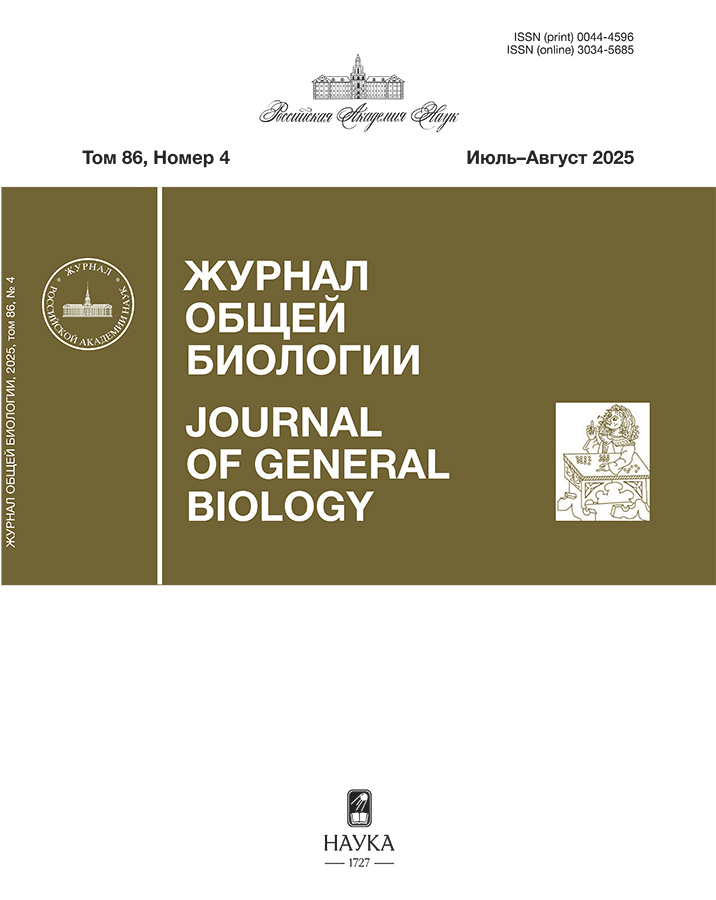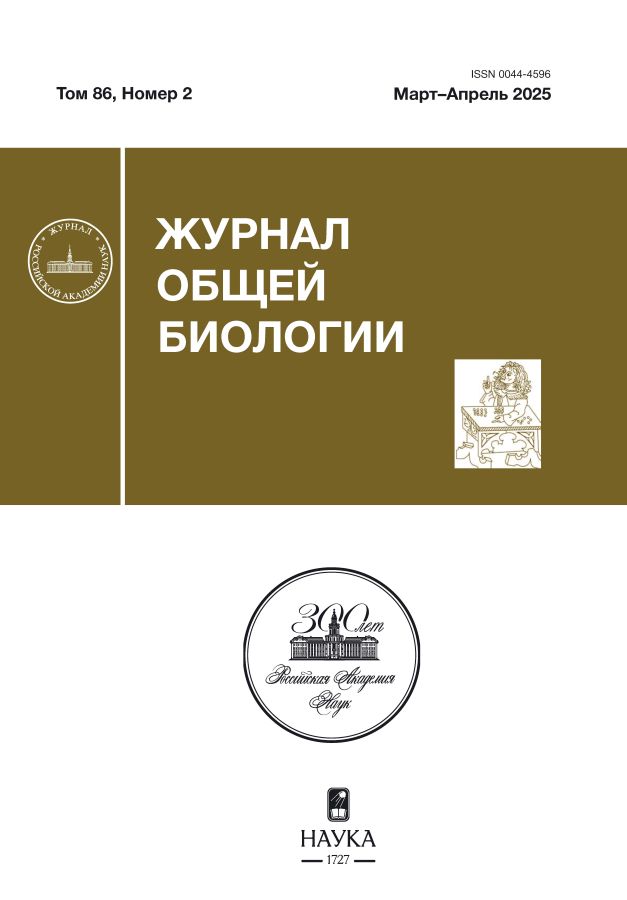Эколого-биологические особенности динамики численности пополнения и нерестовой биомассы запасов тресковых (Gadiformes: Gadidae) в северной части Атлантического океана
- Авторы: Мельников С.П.1, Кровнин А.С.1, Мурый Г.П.1
-
Учреждения:
- Всероссийский научно-исследовательский институт рыбного хозяйства и океанографии (“ВНИРО”)
- Выпуск: Том 86, № 2 (2025)
- Страницы: 127-142
- Раздел: (воспроизводится в журнале “Current Contents”)
- URL: https://rjeid.com/0044-4596/article/view/686041
- DOI: https://doi.org/10.31857/S0044459625020043
- EDN: https://elibrary.ru/AIZLTO
- ID: 686041
Цитировать
Полный текст
Аннотация
Выявлены региональные и трансатлантические статистические связи между многолетними колебаниями численности пополнения и нерестовой биомассы 11 запасов трески, 5 запасов пикши и 4 запасов сайды из различных районов северной части Атлантического океана за период 1946– 2020 гг. Для изучения закономерностей пространственно-временной изменчивости выявленных связей проанализированы особенности биологии и популяционной структуры исследуемых видов, а также антропогенное воздействие (рыболовство) на структуру запасов. Совпадения в колебаниях численности пополнения отмечаются между теми запасами тресковых, которые распределяются в районах с близким диапазоном среднегодовой придонной температура воды, вне зависимости от их географической удаленности. Отсутствие репродуктивной изоляции между запасами способствует синхронизации динамики численности их пополнения. При увеличении временного сдвига от 0 до 5 лет наблюдается рост абсолютных значений коэффициентов корреляции между нерестовой биомассой запасов у всех трех исследуемых видов. Чрезмерная эксплуатация вызывает значительные изменения в структуре нерестовых запасов тресковых. Рост доли рыб младших возрастов и увеличение скорости их полового созревания ведет к снижению качества производителей, существенно влияя на численность пополнения и величину нерестовой биомассы запасов тресковых.
Ключевые слова
Полный текст
Об авторах
С. П. Мельников
Всероссийский научно-исследовательский институт рыбного хозяйства и океанографии (“ВНИРО”)
Автор, ответственный за переписку.
Email: melnikov@vniro.ru
Россия, Окружной проезд, 19, Москва, 105187
А. С. Кровнин
Всероссийский научно-исследовательский институт рыбного хозяйства и океанографии (“ВНИРО”)
Email: melnikov@vniro.ru
Россия, Окружной проезд, 19, Москва, 105187
Г. П. Мурый
Всероссийский научно-исследовательский институт рыбного хозяйства и океанографии (“ВНИРО”)
Email: melnikov@vniro.ru
Россия, Окружной проезд, 19, Москва, 105187
Список литературы
- Бирман И.Б., 1966. Влияние климатических факторов на динамику численности горбуши // Вопр. ихтиологии. Т. 6. № 2. С. 208–221.
- Бойцов В.Д., Лебедь Н.И., Пономаренко В.П., Пономаренко И.Я., Терещенко В.В. и др., 2003. Треска Баренцева моря: биология и промысел. Изд. 2-е. Мурманск: Изд-во ПИНРО. 296 с.
- Борисов В.М., 1985. Естественная смертность как фактор динамики численности промысловых популяций рыб // Теория формирования численности стад промысловых рыб. М.: Наука. С. 158–166.
- Дементьева Т.Ф., 1976. Биологическое обоснование промысловых прогнозов. М.: Пищ. пром-сть. 236 с.
- Криксунов Е.А., Снетков М.А., 1985. Расширенная модель формирования пополнения нерестового стада рыб // Теория формирования численности стад промысловых рыб. М.: Наука. С. 46–55.
- Кровнин А.С., Мельников С.П., 2023. Динамика запасов тресковых рыб в североатлантическом регионе // Тр. ВНИРО. Т. 192. С. 55–67. https://doi.org/10.36038/2307-3497-2023-192-55-67
- Кушинг Д.Х., 1979. Морская экология и рыболовство. М.: Пищ. пром-сть. 288 с.
- Лебедев В.Д., 1972. Автоколебания и эволюция живой материи // Бюлл. МОИП. Отд. биол. T. 77. № 2. С. 132–139.
- Лукманов Э.Г., Бараненкова А.С., Клименков А.И., 1975. Биология и промысел сайды в североевропейских морях. Мурманск: Мурманское книжное изд-во. 64 с.
- Мухина Н.В., Ярагина Н.А., 1988. Некоторые аспекты динамики пополнения лофотено-баренцевоморской трески в связи с величиной родительского стада // Биология рыб в морях Европейского Севера: Сб. науч. тр. ПИНРО. Мурманск: Изд-во ПИНРО. С. 15–25.
- Саускан В.И., 2011. Рыбы и рыболовство в Атлантическом океане. Калининград: Изд-во КГТУ. 285 с.
- Сонина М.А., 1977. Аркто-норвежская пикша // Промысловые биологические ресурсы Северной Атлантики и прилегающих морей Северного Ледовитого океана. Т. 1. М.: Пищ. пром-сть. С. 321–333.
- Atlantic Cod: A Bio-Ecology, 2019 / Ed. Rose G.A. Hoboken: John Wiley & Sons. 416 p.
- Begg G., 1998. A Review of Stock Identification of Haddock, Melanogrammus aeglefinus, in the Northwest Atlantic Ocean // Mar. Fish. Rev. V. 60. № 4. P. 1–15.
- Bergstad O.A., Jorgensen T., Dragesund O., 1987. Life history and ecology of the gadoid resources of the Barents Sea // Fish. Res. V. 5. P. 119–161. https://doi.org/10.1016/0165-7836(87)90037-3
- Brander K.M., 1994. Patterns of distribution, spawning, and growth in North Atlantic cod: The utility of inter-regional comparisons // ICES Mar. Sci. Symp. V. 198. P. 406–413.
- Brander K.M., 2005. Cod recruitment is strongly affected by climate when stock biomass is low // ICES J. Mar. Sci. V. 62. P. 339–343. https://doi.org/10.1016/j.icesjms.2004.07.029
- Brander K.M., 2007. The role of growth changes in the decline and recovery of North Atlantic cod stocks since 1970 // ICES J. Mar. Sci. V. 64. P. 211–217. https://doi.org/10.1093/icesjms/fsl021
- Brander K., Mahon R., 2004. Effect of the North Atlantic Oscillation on recruitment of Atlantic cod (Gadus morhua) // Can. J. Fish. Aquat. Sci. V. 56. P. 2069–2077. https://doi.org/10.1139/f04-087
- Brodziak J., O’Brian L., 2005. Do environmental factors affect recruits per spawner anomalies of New England groundfish? // ICES J. Mar. Sci. V. 62. P. 1394–1407. https://doi.org/10.1016/j.icesjms.2005.04.019
- Chen Q., Chan K.S., Lekve K., Torstensen E., Gjøsæter J., et al., 2005. Population dynamics of cod Gadus morhua in the North Sea region: Biological density-dependent and climatic density-independent effects // Mar. Ecol. Progr. Ser. V. 302. P. 219–232. 10.3354/meps302219' target='_blank'>https://doi: 10.3354/meps302219
- Clark S.H., Overholtz W.J., Hennemuth R.C., 1982. Review and assessment of the Georges Bank and Gulf of Maine haddock fishery // J. Northwest Atl. Fish. Sci. V. 3. P. 1–27.
- Clay D., Stobo W.T., Hurley P.C., 1989. Growth of juvenile pollock (Pollachius virens L.) along the Atlantic coast of Canada with inference of inshore-offshore movements // J. Northwest Atl. Fish. Sci. V. 9. P. 37–43. http://dx.doi.org/10.2960/J.v9.a3
- Cook R.M., Heath M.R., 2005. The implications of warming climate for the management of North Sea demersal fisheries // ICES J. Mar. Sci. V. 62. P. 1322–1326. http://dx.doi.org/10.1016/j.icesjms.2005.05.006
- DFO, 2023. Stock Status Update of Atlantic Cod (Gadus morhua) in NAFO Divisions 4X5Y for 2022 // DFO Can. Sci. Advis. Sec. Sci. Resp. 2023/017. 22 p.
- Dutil J.D., Brander K., 2003. Comparing productivity of North Atlantic cod (Gadus morhua) stocks and limits to growth production // Fish. Oceanogr. V. 12. P. 502–512. http://dx.doi.org/10.1046/j.1365-2419.2003.00243.x
- Hennemuth R.C., Palmer J.E., Brown B.E., 1980. A statistical description of recruitment in eighteen selected fish stocks // J. Northwest Atl. Fish. Sci. V. 1. P. 101–111. http://dx.doi.org/10.2960/J.v1.a10
- Hutchings J.A., 2005. Life history consequences of overexploitation to population recovery in Northwest Atlantic cod (Gadus morhua) // Can. J. Fish. Aquat. Sci. V. 62. № 4. P. 824–832. http://dx.doi.org/10.1139/f05–081
- ICES, 2002. Workshop on the transport of cod larvae // ICES CM 2002/C:13. 44 p.
- ICES, 2020. Working Group on the Assessment of Demersal Stocks in the North Sea and Skagerrak (WGNSSK). 1353 p. http://dx.doi.org/10.17895/ices.pub.6092
- ICES, 2021а. Inter-Benchmark Process on Western Baltic cod (IBPWEB). 76 p. https://doi.org/10.17895/ices.pub.5257
- ICES, 2021b. Northwestern Working Group (NWWG). 766 p. https://doi.org/10.17895/ices.pub.8186
- ICES, 2023. Baltic Fisheries Assessment Working Group (WGBFAS). 606 p. https://doi.org/10.17895/ices.pub.23123768
- Koslow A.J., Thompson K.R., Silvert W., 1987. Recruitment to northwest Atlantic cod (Gadus morhua) and haddock (Melanogrammus aeglefinus) stocks: Influence of stock size and climate // Can. J. Fish. Aquat. Sci. V. 44. P. 26–39. http://dx.doi.org/10.1139/f87-004
- Mahon R., Smith R.W., 1989. Demersal fish assemblages on the Scotian Shelf, northwest Atlantic: spatial distribution and persistence // Can. J. Fish. Aquat. Sci. V. 46. № S1. P. 134–152. http://dx.doi.org/10.1139/f89–285
- Mayo R.K., McGlade J.M., Clark S.H., 1989. Patterns of exploitation and biological status of pollock (Pollachius virens L.) in the Scotian Shelf, Georges Bank, and Gulf of Maine Area // J. Northwest Atl. Fish. Sci. V. 9. P. 13–36.
- Megrey A.B., Lee Y.W., Macklin S.A., 2005. Comparative analysis of statistical tools to identify recruitment-environment relationship and forecast recruitment strength // ICES J. Mar. Sci. V. 62. P. 1327–1337. http://dx.doi.org/10.1016/j.icesjms.2005.05.018
- Munk P., Larsson P.O., Danielsen D., Moksness E., 1999. Variability in frontal zone formation and distribution of gadoid fish larvae at the shelf break in the northeastern North Sea // Mar. Ecol. Progr. Ser. V. 177. P. 221–233. http://dx.doi.org/10.3354/meps177221
- O’Boyle R., 1993. Fisheries management organizations: A study of uncertainty // Risk Evaluation and Biological Reference Points for Fisheries Management / Eds Smith J.S., Hunt J.J., Rivard D. Ottawa: National Research Council of Canada. P. 423–436.
- Planque B., Fredou T., 1999. Temperature and the recruitment of Atlantic cod (Gadus morhua) // Can. J. Fish. Aquat. Sci. V. 56. P. 2069–2077. https://doi.org/10.1139/f99-114
- Righton D.A., Andersen K.H., Neat F., 2010. Thermal niche of Atlantic cod Gadus morhua: limits, tolerance and optima // Mar. Ecol. Progr. Ser. V. 420. P. 1–13. http://dx.doi.org/10.3354/meps08889
- Robichaud D., Rose G.A., 2004. Stock structure and range in Atlantic cod (Gadus morhua): Inference from 100 years of tagging // Fish Fish. V. 5. № 3. P. 185–214. https://doi.org/10.1111/j.1467-2679.2004.00141.x
- Rose G.A., Nelson J., Mello L.G.S., 2011. Isolation or metapopulation: Whence and whither the smith sound cod // Can. J. Fish. Aquat. Sci. V. 68. P. 152–169. http://dx.doi.org/10.1139/F10-135
- Rose G.A., Rowe S., 2018. Does redistribution or local growth underpin rebuilding of Canada’s Northern cod? // Can. J. Fish. Aquat. Sci. V. 75. P. 825–835. https://doi.org/10.1139/cjfas-2017-0421
- Salvanes A.G.V., Skjæraasen J.E., Nilsen T., 2004. Sub-populations of coastal cod with different behavior and life-history strategies // Mar. Ecol. Progr. Ser. V. 267. P. 241–251. http://dx.doi.org/10.3354/meps267241
- Sætersdal G., Loeng H., 1987. Ecological adaptation of reproduction in Northeast Arctic cod // Fish. Res. V. 5. P. 253–270. https://doi.org/10.1016/0165-7836(87)90045-2
- Smedbol R.K., Wroblewski J.S., 2002. Metapopulation theory and northern cod population structure: interdependency of subpopulations in recovery of a groundfish population // Fish. Res. V. 55. P. 161–174. http://dx.doi.org/10.1016/S0165-7836(01)00289-2
- Sundby S., 2000. Recruitment of Atlantic cod stocks in relation to temperature and advection of copeopod populations // Sarsia. V. 85. P. 277–298. http://dx.doi.org/10.1080/00364827.2000.10414580
- Templeman W., 1966. Marine Resource of Newfoundland. Ottawa: Fisheries Research Board of Canada. 170 p.
- Waiwood K.G., Buzeta M.-I., 1989. Reproductive biology of southwest Scotian Shelf haddock (Melanogrammus aeglefinus) // Can. J. Fish. Aquat. Sci. V.
Дополнительные файлы


















